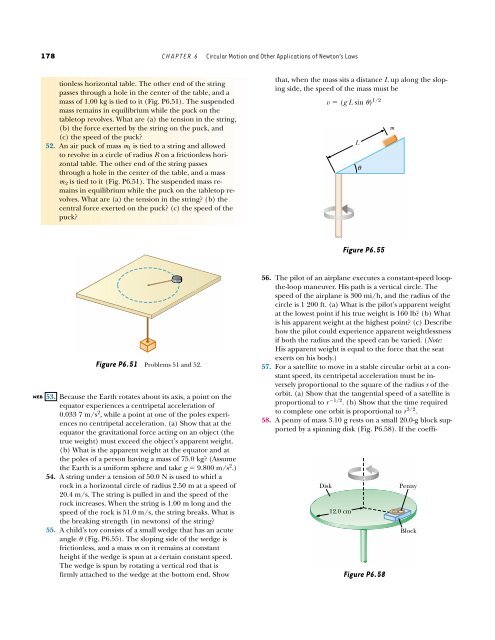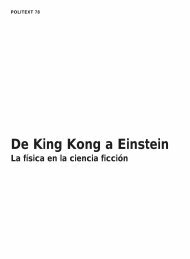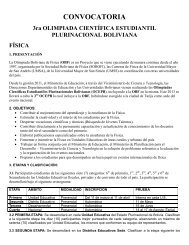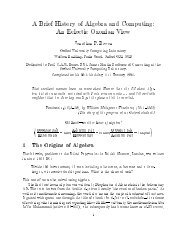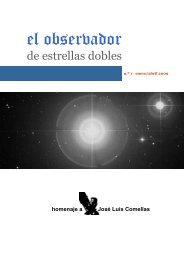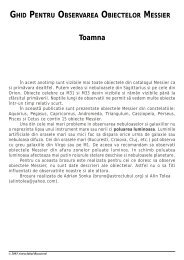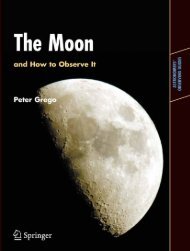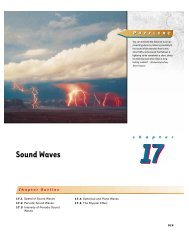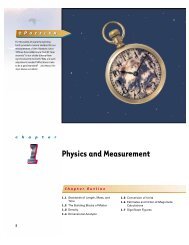Circular Motion and Other Applications of Newton's Laws
Circular Motion and Other Applications of Newton's Laws
Circular Motion and Other Applications of Newton's Laws
Create successful ePaper yourself
Turn your PDF publications into a flip-book with our unique Google optimized e-Paper software.
WEB<br />
178 CHAPTER 6 <strong>Circular</strong> <strong>Motion</strong> <strong>and</strong> <strong>Other</strong> <strong>Applications</strong> <strong>of</strong> Newton’s <strong>Laws</strong><br />
tionless horizontal table. The other end <strong>of</strong> the string<br />
passes through a hole in the center <strong>of</strong> the table, <strong>and</strong> a<br />
mass <strong>of</strong> 1.00 kg is tied to it (Fig. P6.51). The suspended<br />
mass remains in equilibrium while the puck on the<br />
tabletop revolves. What are (a) the tension in the string,<br />
(b) the force exerted by the string on the puck, <strong>and</strong><br />
(c) the speed <strong>of</strong> the puck?<br />
52. An air puck <strong>of</strong> mass m 1 is tied to a string <strong>and</strong> allowed<br />
to revolve in a circle <strong>of</strong> radius R on a frictionless horizontal<br />
table. The other end <strong>of</strong> the string passes<br />
through a hole in the center <strong>of</strong> the table, <strong>and</strong> a mass<br />
m 2 is tied to it (Fig. P6.51). The suspended mass remains<br />
in equilibrium while the puck on the tabletop revolves.<br />
What are (a) the tension in the string? (b) the<br />
central force exerted on the puck? (c) the speed <strong>of</strong> the<br />
puck?<br />
Figure P6.51 Problems 51 <strong>and</strong> 52.<br />
53. Because the Earth rotates about its axis, a point on the<br />
equator experiences a centripetal acceleration <strong>of</strong><br />
0.033 7 m/s 2 , while a point at one <strong>of</strong> the poles experiences<br />
no centripetal acceleration. (a) Show that at the<br />
equator the gravitational force acting on an object (the<br />
true weight) must exceed the object’s apparent weight.<br />
(b) What is the apparent weight at the equator <strong>and</strong> at<br />
the poles <strong>of</strong> a person having a mass <strong>of</strong> 75.0 kg? (Assume<br />
the Earth is a uniform sphere <strong>and</strong> take g � 9.800 m/s 2 .)<br />
54. A string under a tension <strong>of</strong> 50.0 N is used to whirl a<br />
rock in a horizontal circle <strong>of</strong> radius 2.50 m at a speed <strong>of</strong><br />
20.4 m/s. The string is pulled in <strong>and</strong> the speed <strong>of</strong> the<br />
rock increases. When the string is 1.00 m long <strong>and</strong> the<br />
speed <strong>of</strong> the rock is 51.0 m/s, the string breaks. What is<br />
the breaking strength (in newtons) <strong>of</strong> the string?<br />
55. A child’s toy consists <strong>of</strong> a small wedge that has an acute<br />
angle � (Fig. P6.55). The sloping side <strong>of</strong> the wedge is<br />
frictionless, <strong>and</strong> a mass m on it remains at constant<br />
height if the wedge is spun at a certain constant speed.<br />
The wedge is spun by rotating a vertical rod that is<br />
firmly attached to the wedge at the bottom end. Show<br />
that, when the mass sits a distance L up along the sloping<br />
side, the speed <strong>of</strong> the mass must be<br />
v � (g L sin �) 1/2<br />
L<br />
Figure P6.55<br />
56. The pilot <strong>of</strong> an airplane executes a constant-speed loopthe-loop<br />
maneuver. His path is a vertical circle. The<br />
speed <strong>of</strong> the airplane is 300 mi/h, <strong>and</strong> the radius <strong>of</strong> the<br />
circle is 1 200 ft. (a) What is the pilot’s apparent weight<br />
at the lowest point if his true weight is 160 lb? (b) What<br />
is his apparent weight at the highest point? (c) Describe<br />
how the pilot could experience apparent weightlessness<br />
if both the radius <strong>and</strong> the speed can be varied. (Note:<br />
His apparent weight is equal to the force that the seat<br />
exerts on his body.)<br />
57. For a satellite to move in a stable circular orbit at a constant<br />
speed, its centripetal acceleration must be inversely<br />
proportional to the square <strong>of</strong> the radius r <strong>of</strong> the<br />
orbit. (a) Show that the tangential speed <strong>of</strong> a satellite is<br />
proportional to r �1/2 . (b) Show that the time required<br />
to complete one orbit is proportional to r 3/2 .<br />
58. A penny <strong>of</strong> mass 3.10 g rests on a small 20.0-g block supported<br />
by a spinning disk (Fig. P6.58). If the coeffi-<br />
θ<br />
Disk Penny<br />
12.0 cm<br />
Figure P6.58<br />
m<br />
Block


